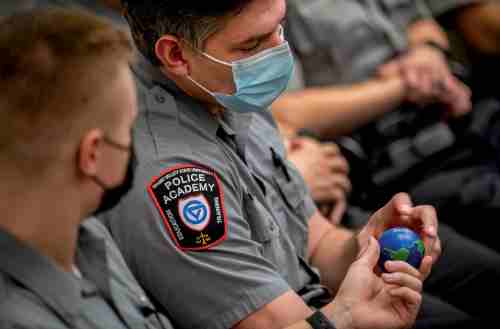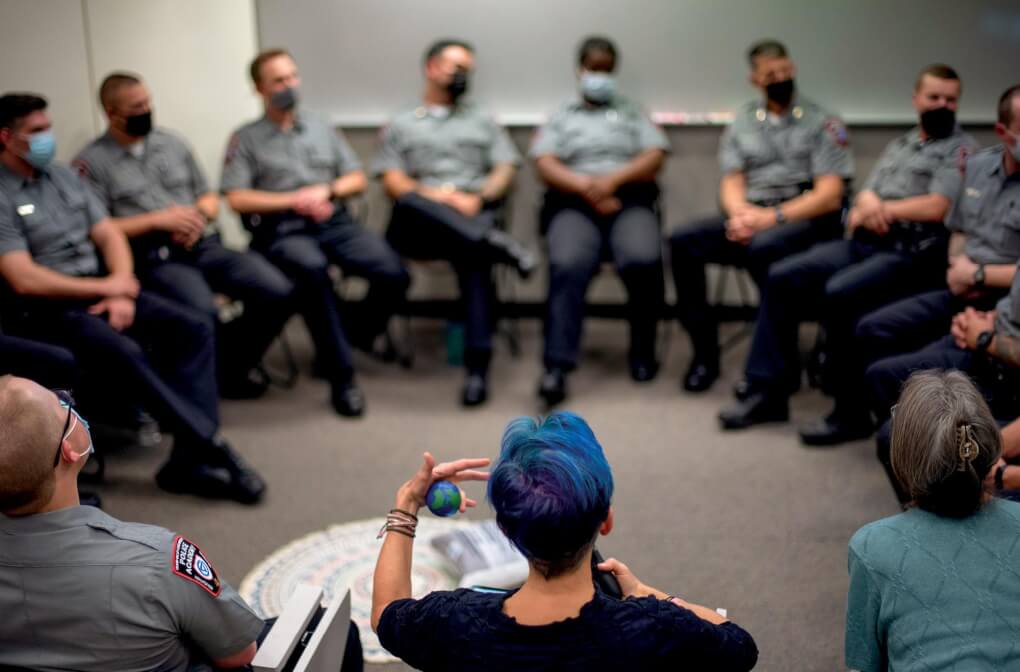T he situation is like many a police officer might answer while on duty.
Two neighbors are bickering over a fallen tree, each pointing fingers at who takes responsibility for the property damage.
But in this case, it’s merely an exercise in a classroom, as cadets in Grand Valley’s Police Academy role play the scenario, practicing conflict resolution techniques and getting a dose of what it will be like as a law enforcement officer trying to diffuse a situation before it becomes volatile or hostile.
A unique partnership between the academy and the nonprofit Dispute Resolution Center of West Michigan in Grand Rapids is providing cadets with the necessary tools in mediation to de-escalate situations they will regularly face, said Williamson Wallace, director of GVSU’s Criminal Justice Training program.
A former law enforcement officer himself, Wallace said the majority of calls these cadets will eventually respond to are non-criminal.
“When you look at the majority of what the officer does, it’s going out there trying to diffuse things and give people resources,” said Wallace. “If they’re unable to communicate effectively in these situations, then sometimes the situations tend to escalate. We want to give the cadets all the tools necessary so they can properly handle situations so they’re not put in a position where they have to use force.”

Academic studies and research support Wallace.
In a 2020 article, “Disaggregating the Police Function,” Barry Friedman, director of the Policing Project at New York University’s School of Law, found police are called upon to fill a variety of roles.
In his study, Friedman revealed the majority of interactions for police with civilians occur in two settings: on the road (helping motorists, assisting with car crashes, issuing citations) or as a mediator (domestic disputes, noise complaints, trespassing, rowdiness).
Those situations often induce stress in people, amplify their emotions and limit their problem-solving skills, requiring law enforcement to be the objective voice by providing an opportunity for dialogue, said Christine Gilman, executive director of the Dispute Resolution Center.
“When people call the police, they are in a heightened state,” said Gilman. “They are not in a state where they are open to problem-solving. So we’re trying to give the cadets the skills they need to de-escalate people and get them in a place where they are more open to having those conversations."


Evolution of police training
With law enforcement agencies facing scrutiny over their usage of force, sometimes with tragic consequences, Wallace said GVSU shifted its training philosophy in 2015.
“There’s been a move away from this warrior mentality in law enforcement to a guardian mentality,” said Wallace.
A 2013 report by the U.S. Department of Justice studied police academies and their nearly 135,000 recruits over a two-year period. Their findings show 48 percent of those 135,000 recruits were trained by academies using a model similar to military training, which “typically involves intensive physical demands and psychological pressure.”
Jennifer Marson-Reed, assistant professor of criminal justice at Grand Valley, said policing 30 years ago was different than today.
“If we look at the history of law enforcement, we’ve not always taken a restorative approach to policing,” she said.
Marson-Reed approached Wallace and Paul Stansbie, associate dean in the College of Education and Community Innovation, about incorporating cadet training for mediation and restorative practices with the help of the Dispute Resolution Center of West Michigan.
“What the Dispute Resolution Center has done is entirely unique,” said Marson-Reed. “They’ve created a hybrid model and tailored the training to specific situations that law enforcement will see.”
The nonprofit developed the curriculum, applying its experience of 35 years with conflict resolution in a variety of situations across civil, employment and personal matters and modifying curriculum suited to law enforcement, said Gilman.
“Historically, we’ve been training different community members and people in schools to do restorative practices, so to us, this is an extension of that,” said Gilman. “The process is the same. It’s all about relationships, whether you are a teacher in a classroom or a police officer on a beat.”
Marson-Reed said the Michigan Commission on Law Enforcement Standards requires police academies to provide eight hours of training in interpersonal communications such as mediation and restorative practices.
The Grand Valley program provides 40 hours, 30 in the classroom and 10 online. Cadets and instructors from the center meet once a week in four-hour sessions for 10 weeks, delving into a variety of scenarios and communicative practices.
Educators from the center describe scenarios for cadets to practice, before they disperse into smaller groups to role play. After 20 minutes, the cadets regroup to talk about how they responded and why, their personal emotional state and what they’ve learned.
To keep track of their progress, cadets keep journals during the 10 weeks using the time for reflection and self-awareness.
“It’s not their job to solve it, but at that moment, it’s their job to ask, ‘What do you need to solve the problem, and how can it be resolved?’” said Marilyn Booker, the center’s restorative practices director. “It’s about having people use their language to say what they feel is happening.”
Based on his research, Wallace said the GVSU Police Academy is the only one in the nation with this level and coursework of training, addressing mediation and restorative practices.
“You’re dealing with humans, and you need to understand what motivates people, how to effectively communicate with individuals, and understand human nature,” said Wallace. “In my experience, nine times out of 10, people just want to be heard. If we can resolve this situation, in the long term, we’re not coming back, and there’s not going to be a repeat 911 call.”
Marson-Reed said she hopes the skills cadets are developing can influence other police academies and law enforcement agencies to implement the training.
“My hope is that 10 years from now this type of training is being added to every police academy in the country to help repair fractured relationships between law enforcement and the community,” said Marson-Reed.




Cadets keep a journal during the 10-week, 40-hour mediation class to reflect and help them track their progress in resolution dispute scenarios.







